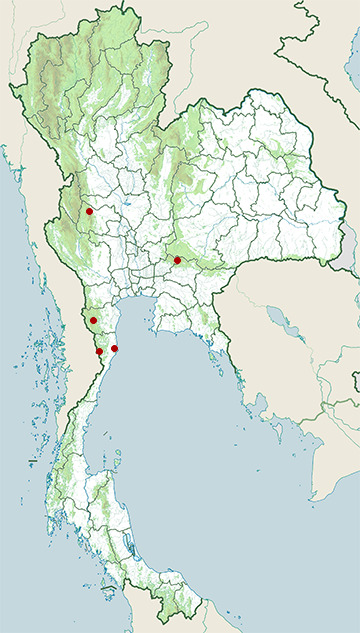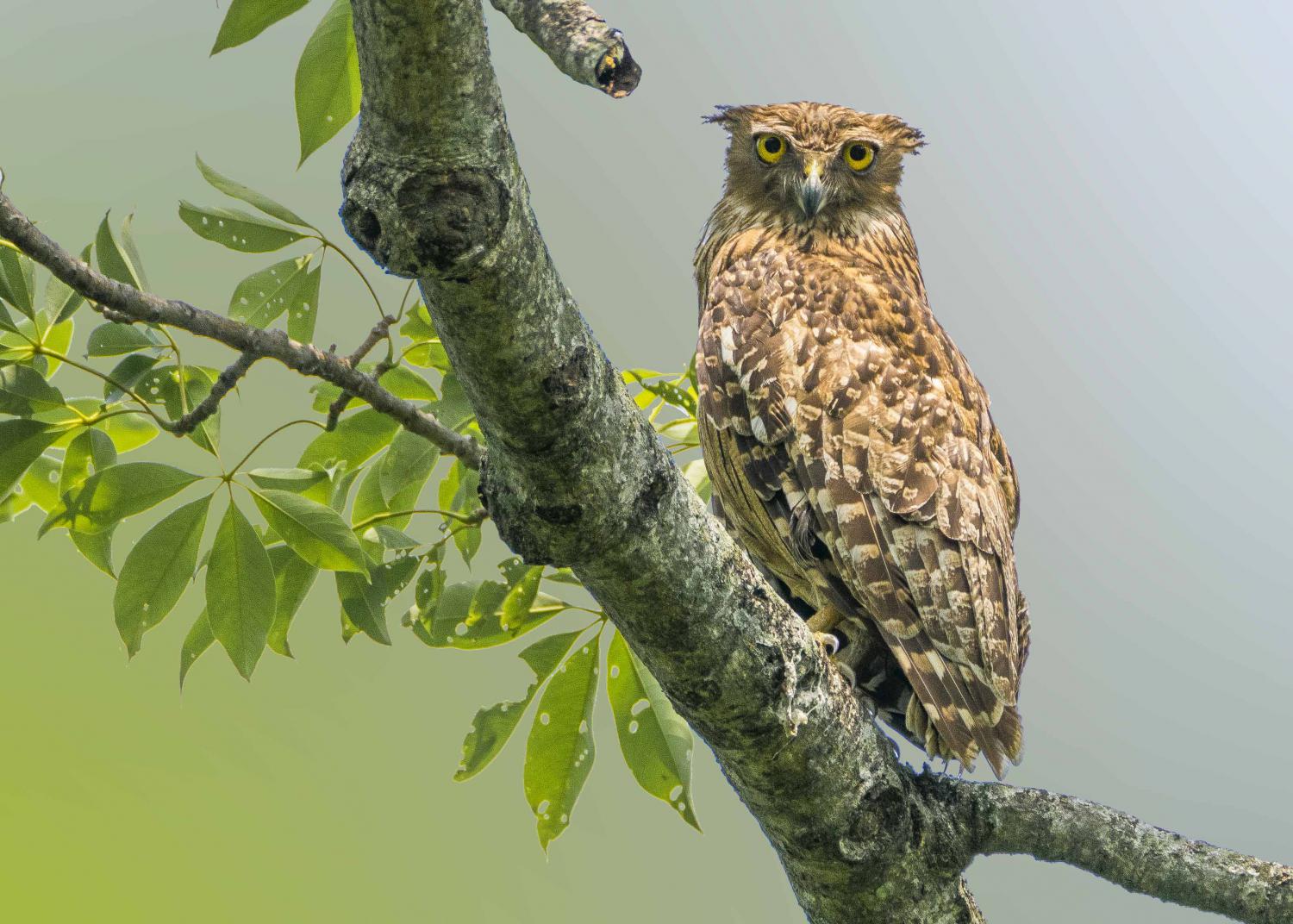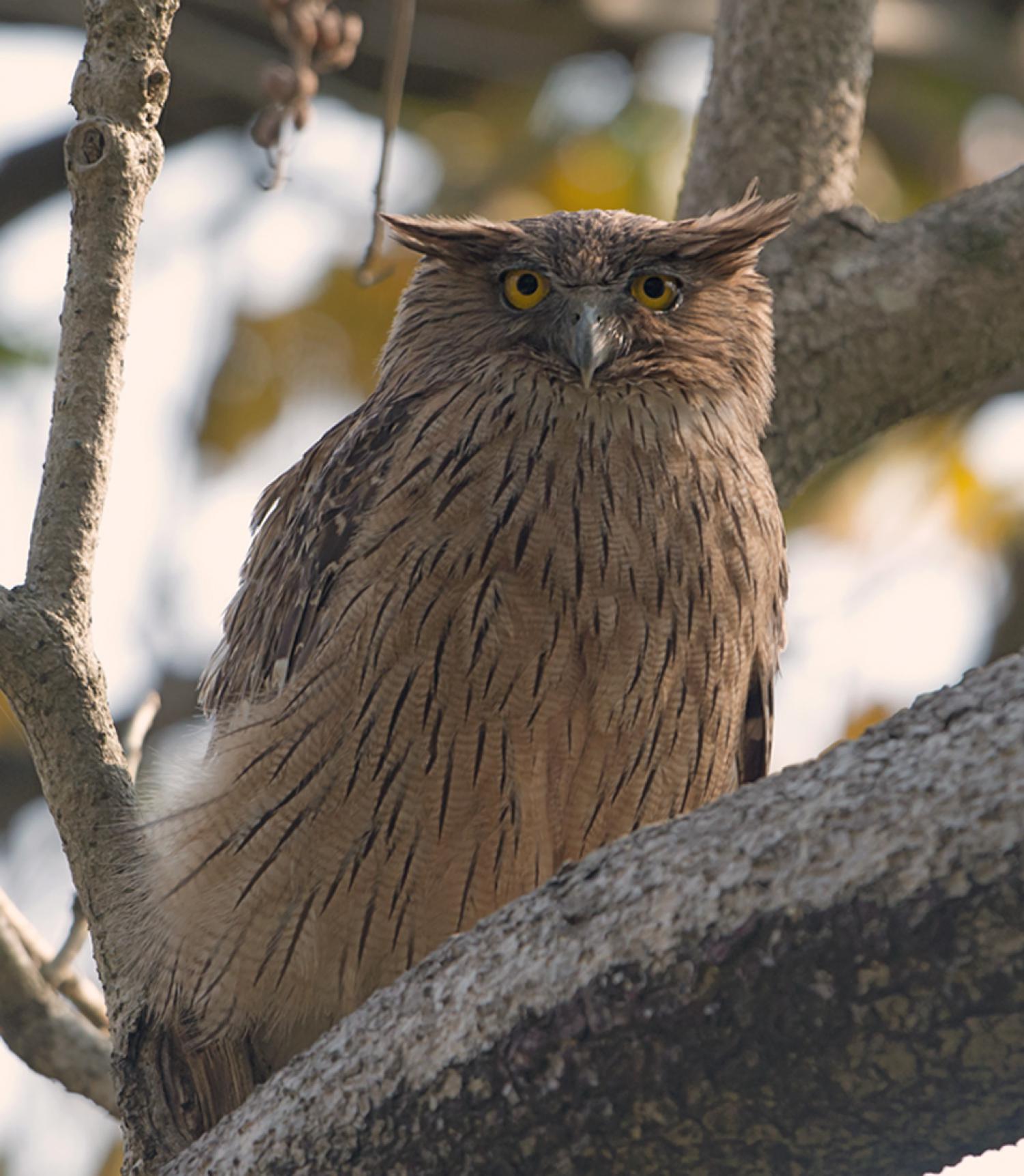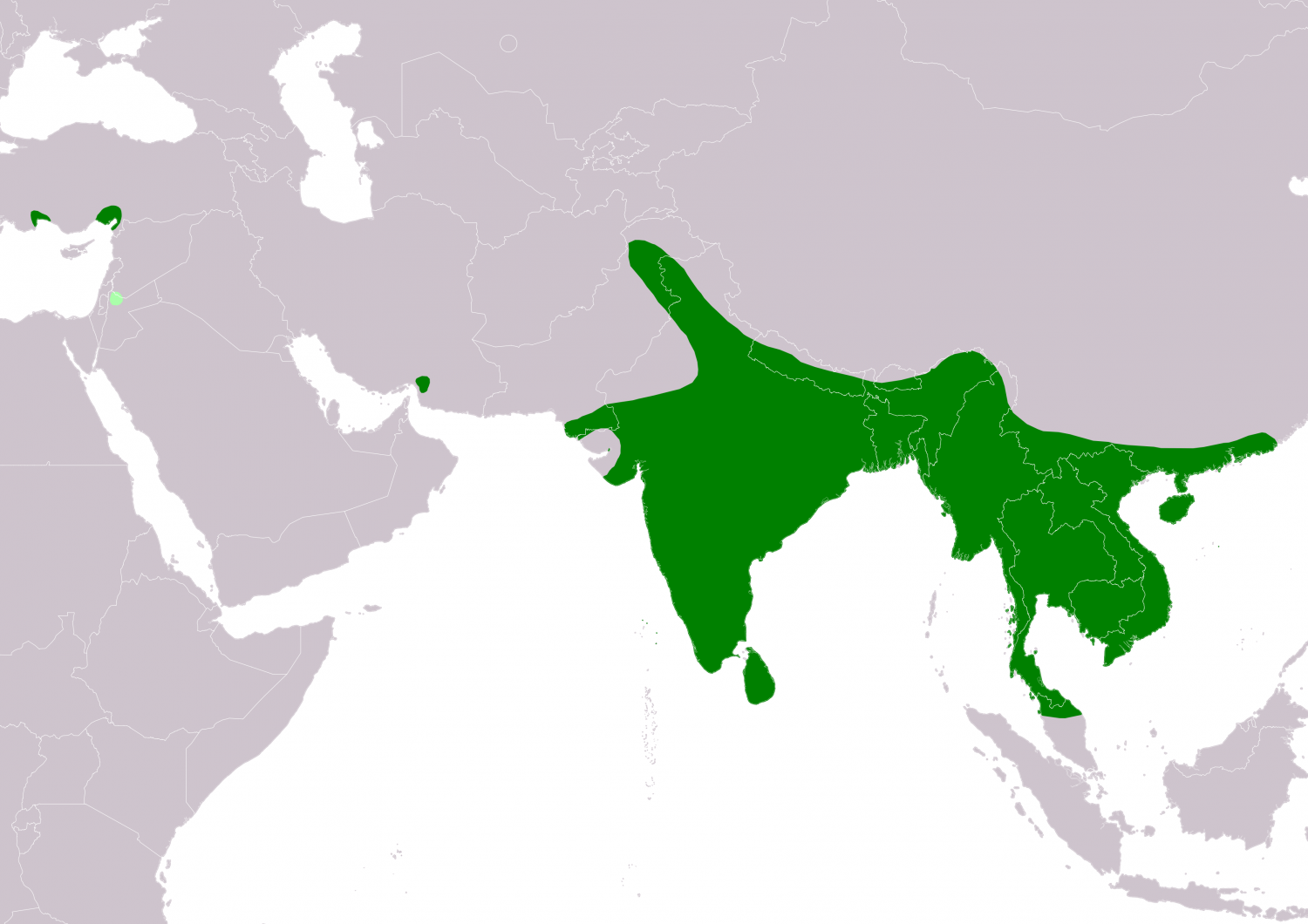Species of Thailand
Brown fish owl
Ketupa zeylonensis
Johann Friedrich Gmelin, 1788
In Thai: นกทึดทือพันธุ์เหนือ
The brown fish owl (Ketupa zeylonensis) is a fish owl species in the family known as typical owls, Strigidae. It is native from Turkey to South and Southeast Asia. Due its wide distribution it is listed as Least Concern on the IUCN Red List. It inhabits forests and wooded wetlands. Of the four living species of fish owl, it is the most widely distributed, most common and best-studied. It occupies a range of over 7000 km.
Taxonomy
Strix zeylonensis was the scientific name proposed by Johann Friedrich Gmelin in 1788 for a fish owl from Sri Lanka. In the 19th and 20th centuries, several brown fish owl specimens were described:
- Strix Leschenault by Coenraad Jacob Temminck in 1820 was a fish owl collected in India by Jean-Baptiste Leschenault de La Tour. It was placed in Ketupa proposed as generic name by René-Primevère Lesson in 1831 for fish owl species from Java and India. Lesson renamed it to Ketupa Leschenaultii.
- Ketupa semenowi proposed by Nikolai Zarudny in 1905 were a male and a female fish owl from the Zagros Mountains in western Iran.
- Ketupa ceylonensis orientalis proposed by Jean Théodore Delacour in 1926 were two female specimens collected in Vietnam that slightly differed in colour from brown fish owls in Laos.
Results of a phylogenetic analysis of nine horned owl species indicate that Ketupa species form a monophyletic group. Currently, the brown fish owl is classified in the genus Ketupa and four subspecies are recognised as valid taxa:
- Sri Lankan brown fish owl (K. zeylonensis zeylonensis) is the smallest and darkest coloured subspecies with a wing chord of 355 to 405 mm, a tarsus of 85 to 90 mm, a tail of 177 to 206 mm, and a bill of 42 to 48 mm. The wing length averages 92% shorter than in northern subspecies. One male was found to have weighed 1100 g.
- Common brown fish owl (K. z. leschenaultii) occurs from the Indian subcontinent to Myanmar and Thailand. It is of medium hue with lighter markings than the nominate subspecies. It has a wing chord of 370 to 430 mm, a tail of 186 to 210 mm, a tarsus of 71 to 90 mm and a bill of 49 to 52 mm. The wing chord of 16 males in India averaged 402 mm and their bills averaged 49 mm while 15 females averaged 395 mm in wing chord and 51.5 mm in bill length. A male was found to weigh 1105 g and a female was found to weigh 1308 g.
- Western brown fish owl (K. z. semenowi) occurs from southern Turkey through Iran and Pakistan to northeastern India. It is paler and slightly larger than the common brown fish owl with a somewhat tawny hue. Its wing chord is 396 to 434 mm with a tarsus of 74 to 90 mm, a tail of 197 to 214 mm and a bill of 49 to 54 mm.
- Eastern brown fish owl (K. z. orientalis) occurs in north-eastern Myanmar, Vietnam and southeastern China and Hainan Island. It is somewhat darker than the common brown fish owl with a larger tarsus. Its wing chord is 365 to 457 mm, with a tail of 195 to 210 mm and a tarsus of 67 to 70 mm.
Fossil records
In prehistoric times, this species may have been present across the central and eastern Mediterranean basin, in particular on islands. The Late Pleistocene Bubo insularis is typically considered to include the fragmentary remains originally described as Ophthalmomegas lamarmorae due to a mix-up with the fossil macaque Macaca majori and subsequently unstudied for many decades. Its fossil bones suggest a bird the size of a large spotted eagle-owl (B. africanus), a bit smaller still than the smallest living fish owls. It was certainly smallish but long-legged by eagle-owl standards, and its wing proportions differed conspicuously from a typical horned eagle owl. On the other hand, its leg and foot bones were more similar to those of a typical eagle-owl. Some consider it a specialized paleosubspecies of the brown fish owl.
Its oldest remains date back at least to the Early Pliocene, about 5 million years ago. It was probably widely distributed around 120, 000 years ago. After the onset of the last glacial period, less than 100, 000 years ago, it disappeared from the western part of its range. The Late Miocene-Early Pliocene "Strix" perpasta is unlikely to belong in that genus, and also sometimes merged with B. insularis.
Description
The brown fish owl has prominent ear tufts and rufous brown upperparts that are heavily streaked with black or dark brown. Its underparts are buffy-fulvous to whitish, with wavy dark brown streaks and finer brown barring. Its throat is white and conspicuously puffed. Its facial disk is indistinct, the bill dark and the iris golden yellow. Its featherless feet are yellow. Two-year old brown fish owls are somewhat paler than adults. Female and male differ slightly in size.
In body size, it ranges from 48 to 61 cm with a wingspan from 125 to 140 cm. Its weight varies considerably, ranging from 1.1 to 2.5 kg. Some of the variability is attributed to the range of sizes across the subspecies. Also, females are invariably at least somewhat larger than males and condition of birds is variable. It is slightly larger than the buffy fish owl with a darker brown hue.
Compared to eagle owls of similar length, fish owls tend to be even shorter in tail length and even heavier in build, have relatively larger wings, have considerably longer legs, and have a rough texture to the bottom of their toes. At least the latter two features are clear adaptations to aid these owls in capturing fish. Diurnal raptors who feed largely on fish have similar, if not identical, rough texture under their toes, which helps these birds grasp slippery fish. Unlike diurnal raptors who capture fish such as the osprey (Pandion haliaetus) as compared to most terrestrial raptors, the fish owls have large, powerful, and curved talons and a longitudinal sharp keel sitting under the middle claw with all having sharp cutting edges that are very much like those of eagle owls. Also, unlike fish-eating diurnal raptors will not submerge any part of their body while hunting, preferring only to put their feet into the water, although fish owls will hunt on foot, wading into the shallows. Unlike most owls, the feathers of fish owls are not soft to the touch and they lack the comb and hair-like fringes to the primaries, which allow other owls to fly silently in order to ambush their prey. Due to the lack of these feather-specializations, fish owl wing beats make sounds. The brown fish owl in particular is said to have a noisy wing beat, sometimes described as producing a singing sound, but another description claimed they could be "as silent as any other owl" in flight. The lack of a deep facial disc in fish owls is another indication of the unimportance of sound relative to vision in these owls, as facial disc depth (as well as inner ear size) are directly related to how important sound is to an owl's hunting behavior. Also different from most any other kind of owl, the bill is placed on the face between the eyes rather below it, which is said to impart this fish owl with a "remarkably morose and sinister expression". Similar adaptations, such as unwillingness to submerge beyond their legs and lack of sound-muffling feathers are also seen in the African fishing owls, which do not seem to be directly related. The brown fish owl has sometimes been regarded as conspecific with the Blakiston's fish owl (B. blakistoni), but there is an approximately 2000 km gap in their distributions, not to mention a large number of physical differences not the least of which is the Blakiston's considerably greater size.
Distribution and habitat
The brown fish owl is an all-year resident throughout most tropical and subtropical parts of the Indian Subcontinent to Southeast Asia and adjoining regions. West of its main range, it is patchily distributed to the Levant (possibly extinct) and southern Asia Minor (recently rediscovered). The typical habitat of brown fish owls is forest and woodland bordering streams, lakes or rice fields. It inhabits mainly the lowlands, from open woodland to dense forest as well as in plantations; in the Himalayas foothills it ranges into submontane forest up to 1500 m above mean sea level or so but not higher. It frequently spends the day in stands of bamboo or other large shady trees. They be found around water reservoirs, along canals, on the outskirts of villages and along sea coasts. Western birds are found in semiarid landscape and may breed in oases in arid regions. Regardless of habitat, it rarely strays far from larger bodies of water such as rivers and lakes.
Being a large predatory bird, the brown fish owl is only rarely found at a high population density, an exception being Sri Lanka, where this particular owl's adaptability to human habitat change has been beneficial in continued high numbers.
Behaviour and ecology
The calls of the buffy fish owl are described as a deep humming boom-uh-boom, a hup hup hu and a loud huhuhuhuhuhuhu. A trisyllabic tu-hoo-hoo is seemingly the territorial song emitted before breeding. Its call has been described as comparable to that of a distant Eurasian bittern (Botaurus stellaris).
The buffy fish owl is nocturnal but can often be located by the small birds that mob it while roosting in a tree. However, in some areas it may be semi-diurnal and has been seen hunting during daytime, especially in cloudy weather. Brown fish owl primarily hunt by stationing itself on a rock overhang or hanging perch over water, or by wading into shallow waters. It grabs food by gliding over the water, nearly skimming it with its feet and grabbing its prey by quickly extending its long legs. It feeds mainly on fishes, frogs and aquatic crustaceans, especially Potamon crabs. It usually selects the larger freshwater fish available in waterways. Compared to the tawny fish owl, which prefers flowing waters, brown fish owls frequently hunt in still or stagnant waters. By number in the Melghat Tiger Reserve in India, freshwater crabs of the family Gecarcinucidae (of genus Barytelphusa) almost totally dominated the diet. Brown fish owls may be attracted to ornamental fish ponds or commercial fisheries in order to exploit the easily caught fish at such locations. Amniotes, in particular terrestrial ones, are seldom taken. However, other recorded foods have included snakes, lizards, water beetles, other insects, small mammals (including bats) and occasionally water birds. In Melghat, the largest biomass of food consisted of small mammals, namely rats (Rattus ssp.), other types of murids and Asian house shrews (Suncus murinus). Birds hunted by brown fish owls have including lesser whistling duck (Dendrocygna javanica) and Indian pond heron (Ardeola grayii). One unusual prey item recorded was a 28 cm long monitor lizard. Competition may occur between this species and Pallas's fish eagles (Haliaeetus leucoryphus) as well as dusky eagle owls (B. coromandus), but the brown fish owl is more terrestrial than the fish eagle and consumes more invertebrates than either of those species, the eagle feeding mainly on fish followed by water birds and the eagle owl feeding mainly on mammals followed by land birds. If hungry, brown fish owls will scavenge carrion, a rare behavior for owls. A case where a putrefying crocodile (Crocodylus ssp.) carcass was consumed by this species was observed.
As mentioned above, the prehistoric B. insularis is sometimes included in the brown fish owl. If this is correct, the different foot anatomy, more similar to that of a typical eagle-owl, would imply that the population had shifted back to terrestrial prey. A likely prey item in this case would have been the Sardinian pika (Prolagus sardus). It has been conjectured that the owls disappeared with their prey due to climate change, but the giant pikas of Sardinia and Corsica still existed around 1750, finally succumbing to habitat destruction, introduced predatory mammals and overhunting soon thereafter.
Reproduction
Brown fish owls breed from November to April, with activity tending to peak a bit earlier in the north of their breeding range and a bit later in the more tropical south of their breeding range. The breeding season is concurrent with the dry season, which has the benefit of low water levels and thus crabs and fish being more readily assessible. However, most other owls and diurnal raptors also primarily breed in the dry season as well. As owls do not build nest, brown fish owls are somewhat opportunistic when it comes to nesting sites. Brown fish owls frequently nest in shady spots such as old-growth mango trees (Mangifera ssp.), fig trees, including Ficus religiosa and Ficus benghalensis, Shorea robusta and other large trees in lowland forests. Outside of the bare surface of large branches, nests are often in spots such as overgrown eroded ravines and steep riverbanks with natural holes. However, it may also nest near suitable villages, along wet roadsides, jheels, canals and rice fields. Usually nest are large natural holes, in hollows or at the base of large branches. Deserted nest built by fish eagles and vultures are also sometimes used as nesting locations. Other nesting sites have included rock ledges, caves in shady cliff faces and stone ruins. The clutch is two or occasionally just one egg. 10 eggs in India averaged 58.4 x 48.9 mm in sizes, with eggs of fish owls to the north averaging slightly larger. Incubation is 38 days or somewhat less, and the young fledge after about seven weeks. The downy chicks are mostly an off-white color and develop into a paler version of adults by their second year.
Threats
Apparently in India, during the festival of Diwali, thousands of owls are killed - though programs to counter this practice are underway - including this species due to superstitious beliefs about the evil nature of owls and as an attempt to gain the power of black magic. Habitat destruction will eventually cause the species to desert a region. Due to this, it seems to be extinct as a breeding bird in Israel nowadays, attributable largely to damming practices leading to drying up of many waterways. In Israel, it was decimated by the use of the rodenticide Thallium(I) sulfate, which in addition to potential direct exposure through rodents also poisons surface waters.
Further reading
- Mlíkovský, Jiří (2002): Cenozoic Birds of the World, Part 1: Europe. Ninox Press, Prague.
- Mourer-Chauviré, Cécile (2004): . Auk 121 (2): 623–627.
- Olsen, Jery; Wink, Michael; Sauer-Gürth, Heidi & Trost, Susan (2002): A new Ninox owl from Sumba, Indonesia. Emu 102 (3): 223–231.
- Pavia, Marco (1999): Un cranio di Bubo insularis Mourer-Chauviré & Weesie, 1986 (Aves, Strigidae) nelle brecce ossifere del Pleistocene di Capo Figari (Sardegna, Italia) . Atti della Accademia delle Scienze di Torino, Classe di Scienze fisiche, matematiche e naturali 133: 1–10 .
- van den Berg, Arnoud B.; Bekir, Soner; de Knijff, Peter & The Sound Approach (2010): Rediscovery, biology, vocalisations and taxonomy of fish owls in Turkey. Dutch Birding 32: 287–298.
This article uses material from Wikipedia released under the Creative Commons Attribution-Share-Alike Licence 3.0. Eventual photos shown in this page may or may not be from Wikipedia, please see the license details for photos in photo by-lines.
Category / Seasonal Status
BCST Category: Recorded in an apparently wild state within the last 50 years
BCST Seasonal status: Resident or presumed resident
Scientific classification
- Kingdom
- Animalia
- Phylum
- Chordata
- Class
- Aves
- Order
- Strigiformes
- Family
- Strigidae
- Genus
- Ketupa
- Species
- Ketupa zeylonensis
Common names
- Thai: นกทึดทือพันธุ์เหนือ
Subspecies
Bubo zeylonensis insularis, Cécile Mourer-Chauviré & Peter D. M. Weesie, 1986
Range: Its oldest remains date back at least to the Early Pliocene, about 5 million years ago (Ma). It was widely distributed around 120, 000 years ago. After the onset of the last glacial period, less than 100, 000 years ago, this population disappeared from the western part of its range, while in the Middle East semenowi – fossil bones indistinguishable from which are known since about the Gelasian, c. 2 Ma – would have subsumed any remnants of the eastern Mediterranean population. The Late Miocene-Early Pliocene taxon "Strix" perpasta is unlikely to belong in that genus, and also sometimes merged with B. (z.) insularis.
Bubo zeylonensis leschenault, Coenraad Jacob Temminck, 1820
Range: Common brown fish owl. Indian subcontinent to Myanmar (except NE) and Thailand. Might include orientalis. It is of medium hue with lighter markings than the nominate (zeylonensis) and B. z. orientalis but darker than B. z. semenowi. This race is larger than the Sri Lankan subspecies but smaller than the following two races. The wing chord is 370 to 430 mm, the tail is 186 to 210 mm, the tarsus is 71 to 90 mm and the bill is 49 to 52 mm. The wing chord of 16 males in India averaged 402 mm and their bills averaged 49 mm while 15 females averaged 395 mm in wing chord and 51.5 mm in bill length. A male was found to weigh 1105 g and a female was found to weigh 1308 g.
Bubo zeylonensis orientalis, Jean Théodore Delacour, 1926
Range: Eastern brown fish owl. NE Myanmar, Vietnam and SE China. Possibly not distinct from leschenault. Somewhat darker than leschenault. B. z. orientalis is lso larger on average than leschenault. The wing chord is 365 to 457 mm, the tail is 195 to 210 mm and the tarsus is 67 to 70 mm.
Bubo zeylonensis semenowi, Nikolai Alekseyvich Zarudny, 1905
Range: Western brown fish owl. Levant (possibly extinct) and S Asia Minor through Mesopotamia (no up-to-date observations) to Pakistan. Paler than leschenault. Possibly a separate species. The palest race of brown fish owl, with a somewhat tawny hue. This is a large-bodied race, slightly larger than B. z. leschenault in linear dimensions but possibly considerably heavier in some cases. The wing chord is 396 to 434 mm, the tail is 197 to 214 mm, the tarsus is 74 to 90 mm and the bill is 49 to 54 mm.
Bubo zeylonensis zeylonensis, Johann Friedrich Gmelin, 1788
Range: Sri Lankan brown fish owl. Sri Lanka. The smallest and most dark subspecies. The wing chord is 355 to 405 mm, the tail is 177 to 206 mm, the tarsus is 85 to 90 mm and the bill is 42 to 48 mm. The wing length averages 92% shorter than in northern races. One male was found to have weighed 1100 g.
Synonyms
- Bubo zeylonensis, Johann Friedrich Gmelin (1788)
- Strix zeylonensis, Johann Friedrich Gmelin (1788)
- Ketupa zeylonensis, Johann Friedrich Gmelin (1788)
Photos
Please help us review the bird photos if wrong ones are used. We can be reached via our contact us page.
Range Map

- Huai Kha Khaeng Wildlife Sanctuary
- Kaeng Krachan National Park
- Khao Sam Roi Yot National Park
- Khao Yai National Park
- Kui Buri National Park







